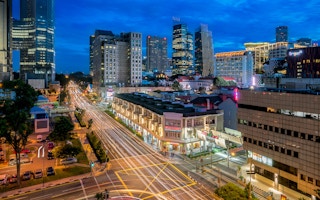If the global economy could chart an ecologically sustainable path, all growth-aspiring countries would benefit. The strongest reason is that low-carbon growth will slow the dangerous pace of climate change. The system, however, remains firmly in pursuit of short-term GDP growth—even as it is proving to be a recipe for ecological catastrophe.
The crucial question is which of the three growth strategies countries will adopt. The first, business-as-usual mode, calls on countries to press for maximum short-term GDP growth, even as it inflicts a high environmental cost.
Second, countries can follow an alternative strategy that takes their eyes off growth measured in terms of GDP, even if this slows or reverses growth, which benefits the environment but likely at the expense of employment creation, at least in the short-term. A third approach adopts adequate regulations that motivate or require businesses to pursue sustainable growth, such as by using non-polluting fuels.
These three growth approaches translate into three pathways of industrial production. In the business-as-usual approach, industry generates vast health hazards from air and water pollution, or high social damage from pollution with little investment in clean-up.
The second strategy would regulate if not cut back industrial production, delivering a salutary impact on the environment and health but also shedding jobs. The third way sets requirements for reducing the use of polluting fuels or increasing use of pollution control equipment, or both – or better still, putting a high enough tax or restriction on emissions which financially motivates industry to cut effluents.
The second and third strategies both reduce environmental damage, but the third strategy, with its focus on job growth, imposes lower social cost than the second strategy. The third approach also entails risk-taking and long-term commitment, and tends to be hindered by political short-sightedness.
Unfortunately, the way countries compute growth makes no distinction on how the growth is generated, and Southeast Asia is no exception to this fatal error. GDP growth forecasts for 2024 are in the range of 5–6 per cent for Vietnam, Cambodia, and the Philippines, 4–5 per cent for Indonesia and Malaysia, 3–4 per cent for Laos, Thailand and Brunei, and 2–3 per cent for Singapore.
These projections do not deduct the negative impacts of fossil fuels, and actions to clean up pollution or repair environmental damage are only counted as positives in GDP, omitting the damage that requires remedy. Conventional measurement of output, indeed, perpetuates policies along the lines of the business-as-usual first scenario above. Southeast Asia’s participation makes the region a part of the climate problem, rather than the solution.
GDP growth targets send the wrong signal, distorting the design of policies that seek to improve people’s lives. UNDP’s Human Development Index (HDI), computed and disseminated as part of the annual Human Development Report (HDR), is a composite indicator with income, education and health components.
The HDI shows how GDP gives only a partial picture. The HDRs also display country rankings based on gross national income (GNI), a modification of GDP that more accurately represents the income received by a country’s residents, juxtaposed with rankings based on HDI scores. Countries that rank better on the GNI per capita chart than the HDI chart have done better in raising output than in improving lives more generally.
For 2022, among 193 countries, Malaysia ranked 56th in gross national income (GNI) but 63rd in HDI; and Thailand was 76th on the GNI chart but did better in HDI (66th) (Figure 1). Combining education and health indicators with GNI improves Thailand’s ranking and lowers Malaysia’s.
The HDI score can also be adjusted for climate impacts by deducting more points in countries that register more negative “planetary impacts”. Malaysia slips 11 places, and Thailand improves 14 places on the planetary index (PHDI); high-income countries register more dramatic changes. Norway is ranked 8th on GNI and improves to 2nd on HDI, then drops 12 spots on the PHDI league table. Singapore, ranked 3rd for GNI and 9th for HDI, slips 38 places to 47th on PHDI.

Figure 1. Selected countries ranked by GNI per capita, HDI and Planetary HDI (2023). Source: Author’s compilations from Human Development Report 2023-24.
With the universal predicament of unprecedented heat waves and catastrophic events, the case for slowing, if not arresting or reversing, growth is getting traction, and the clash with fossil fuel driven growth has heightened. “Degrowth” refers to the view that the pursuit of endless growth as measured by GDP conflicts with the limits of planetary boundaries.
The framing varies, from “doughnut economics” to “zero growth,” but these ideas commonly call into question the unbridled pursuit of growth, especially the ways climate change inflicts costs on economies and societies. Growth remains a powerful anti-poverty tool, but runaway climate change is imposing a huge macroeconomic cost that threatens to arrest growth.
If business as usual continues, even with some tinkering on the margin, global warming will make working conditions impossible, render parts of the planet uninhabitable, and reverse growth and poverty reduction. Consequently, countries might end up with the second, no-growth approach.
However, rather than continuing with business as usual or involuntarily adopting degrowth strategies, countries should shift to tough environmental regulations and a low carbon growth path, which yield vast advantages. For Southeast Asia, this would mean a massive commitment to green investment and a shift of national development targets from narrow GDP growth rates to measures that include social outcomes and environmental damages.
Business as usual versus degrowth in Southeast Asia presents an all-or-nothing choice: either a recipe for a climate catastrophe or a political non-starter. Before the window closes totally on a third way, countries of the region should revise their growth aspirations, replace the quantity of growth with quality of growth, and ensure slow-carbon green growth paths.
Vinod Thomas is currently Visiting Senior Fellow at the ISEAS - Yusof Ishak Institute, and previously Visiting Professor at National University of Singapore. He is a Distinguished Fellow in Development Management at the Asian Institute of Management, Manila, and a member of the advisory panel on climate change at CSEP, New Delhi.
This article was first published in Fulcrum, ISEAS – Yusof Ishak Institute’s blogsite.











